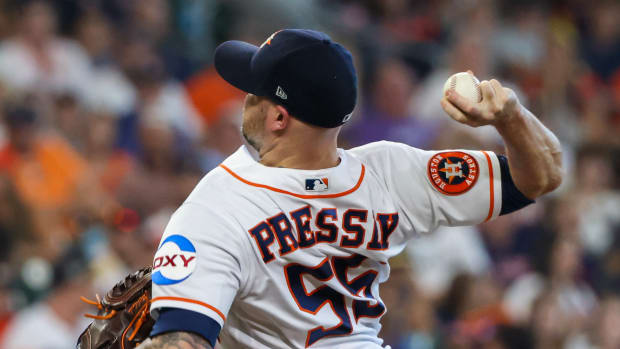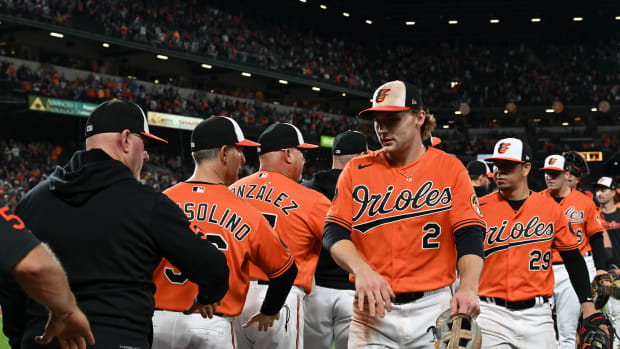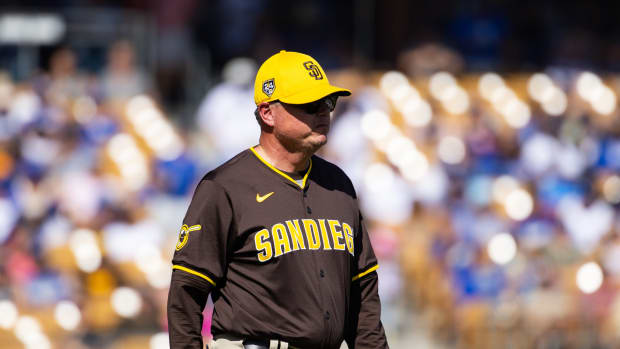James Paxton's No-Hitter Is a Clear Product of Baseball's All-or-Nothing Era
The third no-hitter of the 2018 MLB season and the 299th in professional baseball history belongs to James Paxton of the Seattle Mariners. Over nine innings in Toronto, the big Canadian lefty struck out seven Blue Jays and needed just 99 pitches to finish the job, throwing as hard as 100 mph in his final frame. While it wasn’t as dominant an effort as his 16-strikeout outing last week, Paxton’s no-no perhaps best represents this current era of baseball—an all-or-nothing affair in which making contact has more or less vanished.
Consider that, entering Tuesday’s action, the league as a whole was hitting just .244 this season. That mark ties for sixth lowest in a season of play since 1871, and in the 20th century, only 1908, ‘67 and ‘68 have been worse. The league’s strikeout percentage of 22.7, meanwhile, is its highest ever, topping the previous record of 21.6 set … last year, which in turn broke the 21.1 mark set … the year before. In fact, a new strikeout rate record has been set every single year since 2008. As strikeouts go up, contact has gone down: According to FanGraphs, the league’s swinging-strike rate of 10.7% is the highest on record since 2002, when that stat was first tracked, narrowly edging out last year’s previous champion of 10.5.
All of that adds up to a game where the ball gets put in play less and less, making outings like Paxton’s that much more possible. He did so without a surfeit of strikeouts—in fact, his no-hitter was his first start of the season in which he didn’t record more strikeouts than innings pitched. But he still got plenty of swings and misses, recording 15 on the whole. And he did so as an avatar of that other massive trend that has devoured the game over the last decade: velocity.
Trade to Reds Might Be Worst-Case Scenario for Matt Harvey
Paxton’s four-seam fastball averaged a staggering 95.9 mph on Tuesday, and he maxed out at 100.2. With his second-to-last pitch of the night against Josh Donaldson, he reached 100 on the Mariners broadcast gun; his velocity actually increased as the game went on, as he sat at 97.5 mph in the ninth after starting his outing at 94.7. By Statcast’s measurements, he got as high as 99.5 mph in the ninth, making him one of only six pitchers in the last five years to throw that hard that late in a game—and Paxton is far and away the geezer of the bunch at 29 years old.
Fifteen years ago, Paxton’s 95.5-mph fastball would’ve been the fastest average pitch in baseball among qualified starting pitchers by over a mile per hour, beating Jason Schmidt’s 94.3. Today, though, Paxton’s weapons-grade heat can’t even crack the top five among qualified starters, sitting a full two miles per hour below the fastball of Yankees righty Luis Severino (97.7). Expand that list to include non-qualified starters as well as relievers, and Paxton falls all the way to 50th, sandwiched between two nondescript middle relievers in the Brewers’ Brandon Woodruff and the Dodgers’ Pedro Baez.
Why the Piping Hot Mookie Betts Is One of Baseball's Very Best Players
This is what MLB hitters are asked to face every single game, night in and night out: dozens upon dozens of pitchers, the great majority of whom can run it up to 95 mph and beyond, like Paxton. They do so in an era where defensive shifts have gone from curiosity to commonplace, robbing them of hits through what would’ve been gaps in the infield a decade ago. And because more and more hitters have adopted swings geared toward putting lift on a ball and golfing it out of the park instead of level hacks designed to make contact, they’re going up against pitchers who have mostly abandoned two-seam fastballs or pitching low in the strike zone. Instead, those pitchers are increasingly working high in the strike zone with premium velocity or throwing more and more breaking and offspeed pitches, the persistent bane of any hitter. With hitters selling out for home runs and accepting more strikeouts as the necessary tradeoff, and with pitchers throwing 95-plus with regularity, is it any surprise that it’s become harder and harder to get a hit, or that we’ve already seen three no-hitters before Memorial Day?
Paxton’s no-hitter does represent one break with today’s game, in that he was allowed to finish it. As FanGraphs’ Jay Jaffe noted Monday in the wake of the Dodgers’ combined no-hitter, pitchers are being pulled from no-hitters in progress more and more often. Already this season, five starters have lost a chance at a nine-inning no-hitter because their manager yanked them—the most in a season since 1991, when it happened six times. Most recently, Yankees rookie Domingo German came out of a no-no bid in the sixth, as did Walker Buehler, the first-year player on the mound for Los Angeles who started his team’s successful no-hitter but didn’t get to complete it.
Countdown to Liftoff: How Joey Gallo and Josh Donaldson Embody Baseball's New Era
That the game has trended in this direction is no surprise, given the way franchises increasingly put a premium on protecting arms and on not exposing pitchers to a lineup multiple times. Instead, the preference is to subject hitters to an array of hard-throwing relievers who are tougher to hit than ever before. Thanks in large part to Paxton's efficiency—he didn’t throw more than 20 pitches in any single inning, had three where he threw fewer than 10, and averaged just 11 per frame—Paxton was allowed to get his 27 outs. But efforts like his are increasingly the exception instead of the rule.
By nature, no-hitters are fluky and fickle. While we’ve gotten a rash of them to start the season, there’s no guarantee we’ll see another, and we may end up looking back on this stretch as one of the many statistical hiccups of an average baseball season. But it’s worth noting that the last time we got this many no-hitters this early in a season was 1969, the season after the Year of the Pitcher, when historically bad offensive numbers and a near-record 339 shutouts so spooked MLB that it shrank the strike zone and lowered the height of the pitching mound. And while a trio of no-hitters in the first five weeks of ’69 may have sparked fear in the league office that not enough had been done, things did improve: That year’s collective batting average of .248, while not sterling, was an 11-point jump from the previous season’s record-low .237.
There’s no telling if a similar bounceback is in the offing this year, but barring the league once again putting its thumb on the game’s scales, you shouldn’t expect it. While you may not see many more nights like James Paxton’s, as the solo no-hitter becomes a rarity, the pieces of it are an increasingly large part of this new version of baseball.


































